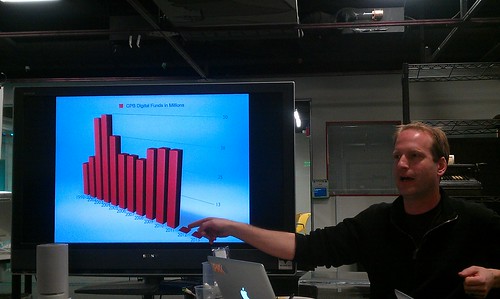Our Civic Lunch this week featured Jake Shapiro, CEO of Public Radio International (PRX), as well as guest John Bracken from the Knight Foundation (which funds the Center for Civic Media).
Ethan Zuckerman frames the conversation by characterizing our beloved but stultified public media institutions as the Death Star, and Shapiro and his friends as the Rebel Alliance. The difference being, of course, that Shapiro and crew are trying to open up and improve public media without resorting to firing photon torpedoes into its exhaust port.
Shapiro launched PRX in the fall of 2003 as an entrepreneurial nonprofit with the goal of using technology to bring compelling content to millions of people. They’ve reshaped the public media landscape in three areas: content, distribution, and innovation.
In the past, if you wanted to distribute a show around the world, you would have to sell a CD or get NPR to beam it. PRX is a clearinghouse where producers share their content (This American Life, The Moth). But it’s not just a platform anymore. Like other organizations, they’ve shifted to curating and producing content, as well.
If you log into PRX.org, you can upload content and earn money, or license others’ content for a fee. Before PRX, many of these stories would be lost to time. Its marketplace makes the long tail of content available, and makes it easy to license and re-use great stories.
A Medium in Transition
Local public radio stations tend to syndicate national shows because it’s easy and the programs are well-known. The local stations often don’t have the capacity to develop unique content. It’s much easier to flip a switch and air something from a national broadcaster than to discover and nurture new talent.
The shift to more participatory media production has required stations to adopt a new workflow. NPR plays a gatekeeping role in this space. To confront this challenge, PRX lets users curate content, and then receive credit when the media they’ve pulled together is rebroadcast by local stations. This curation allows small-time podcasters to reach public radio’s audience (30 million people a week and growing).
Shapiro saw the pieces of this puzzle falling into place and lept at the opportunity to start their own broadcast station. When the FCC approved the XM and Sirius radio merger, they asked the companies to free up some channels for public use. A rapid response and a little bit of luck secured XM channel 123 for PRX. The channel now broadcasts Public Radio Remix, a great mixtape of public radio’s short-form documentary content. Public Radio Remix works under the assumption that, in this era of fragmented media, people are OK with their radio acting in shuffle mode, as long as the stories are well-chosen.
This XM channel is now broadcast 24-hours a day, with some terrestrial stations licensing the stream to supplement their other content or to play overnight.
Bringing the New
PRX has proven itself as an R&D testing ground for new show formats and technologies. “Before iTunes ruined podcasting,” PRX built Podcatcher software that allowed stations to select content for and brand their own podcasting application.
The team at PRX is small, but has been able to innovate thanks to progressive funders like the Knight, Ford, and MacArthur foundations. One example is Public Radio Talent Quest, a national competition to find new and exciting sounds in public media. The result has been a completely different sound than you’re used to hearing on public radio, including winners Snap Judgement and State of the Reunion. 99% Invisible is a show about architecture and design produced by Roman Mars.
PRX has also been developing mobile applications for radio shows, as well as other general public purpose apps. Their Public Radio Player app has 4 million downloads, which, next to NPR’s own News app, serves as one of the biggest aggregators for public radio content. Shapiro wrestles with the tradeoffs of developing apps for the relatively closed marketplaces of Apple and Android, but that’s where the listeners are, and PRX’s iOS and Android apps are profitable, which is great for a small nonprofit.
Serious Challenges for Public Media
 Public media has a bit of a hangup, inhabiting an angstful place somewhere between a superiority complex and an inferiority complex. On the one hand, public media often sees itself as on a mission from God, the mission of shoring up democracy itself. At the same time, public media also sees itself as a media underdog. Basically, public radio is Jim from The Office. He’s cool and funny and even gets the girl, but he’s also stuck working for a paper company in Scranton, PA. Shapiro’s goal is to use PRX as a catalyst to get over this agnst and swing for the fences. In a period of serious media upheaval, Jake wants to change media for good, not just try to catch up.
Public media has a bit of a hangup, inhabiting an angstful place somewhere between a superiority complex and an inferiority complex. On the one hand, public media often sees itself as on a mission from God, the mission of shoring up democracy itself. At the same time, public media also sees itself as a media underdog. Basically, public radio is Jim from The Office. He’s cool and funny and even gets the girl, but he’s also stuck working for a paper company in Scranton, PA. Shapiro’s goal is to use PRX as a catalyst to get over this agnst and swing for the fences. In a period of serious media upheaval, Jake wants to change media for good, not just try to catch up.
This might be necessary. Shapiro showed us a scary graph, angled menacingly toward us, showing that Congress has reduced public funding for digital work in public media to zero. Now, much of the previous years’ appropriation went towards capital-intensive infrastructure and the mandatory switch to digital television broadcasting. But there’s also a larger crisis, where the concept of taxpayer funds going to public media has become an open question in today’s Congress.
Regardless of what Congress ends up doing, there are some in public media see the writing on the wall and would like to get out ahead of the restructuring. It’s clear that Shapiro is one of these forward-thinkers who would rather not wait for Congress to decide his fate. And, in the silver lining department, there are some inefficiencies in public radio. There are stations that merely repeat the same syndicated content over the air, but whose funding mechanisms encourage them to continue on doing just that. As more and more listeners tune in over the web and by podcast, their allegiances shift from their local station to the specific programs they devour.
 This is where we’re at. Public media has had real growth and success, and there is market encouragement to preserve the quality of its content, but it’s all mixed up in a legacy system with liabilities. Jake compares public media to a Jenga Tower, in which people working in public media are afraid to pull out any of the blocks, out of fear that the whole tower will fall down.
This is where we’re at. Public media has had real growth and success, and there is market encouragement to preserve the quality of its content, but it’s all mixed up in a legacy system with liabilities. Jake compares public media to a Jenga Tower, in which people working in public media are afraid to pull out any of the blocks, out of fear that the whole tower will fall down.
Public media has to be concerned not just with where it will get its audiences and revenue in the future, Shapiro says, but also answer the more existential question, in a world with nearly infinite channel space, of the rationale for public media itself, which was built on a pre-Internet philosophy. John Bracken adds, “We’re engaging in a space where most of the players don’t have a Kickstarter strategy.”
Gaining an Appetite for Risk
Jake thinks public media needs to be placing more bets. He can only think of three public media startups (PRX, Public Interactive, and Gather). Public Interactive has become NPR Digital Services, which is considered a successful exit. And Gather.com is a startup based in Boston that built a social network of media producers, with funding from Minnesota Public Radio.
Shapiro sees the building blocks of a public media stack beginning to come together. He sees its layers, from top to bottom, as the Structure (technical backend), Presentation (HTML 5, etc.), Behavior (editors and writers), and lastly, the Media layer (what audiences see). We must also improve the user experience for people looking to find and engage with public media.
With these base layers in place, and the aforementioned economic drivers in effect, public media may just be ready to accelerate.
Together with the Knight Foundation, PRX is working on Public Media Accelerator, to “change media for good.” Shapiro’s invested in marrying the worlds of public media and startup innovation. The Public Media Accelerator is an investment program for early-stage startups, including, notably, for-profit ventures as well as nonprofits. Shapiro asks, “Can we use the successful part of what a for-profit does to attract investors and align incentives to drive innovation?” And, on that note, the PRX Accelerator will take a literal, real equity stake in the for-profits that it funds, and the equity will be held by the PRX Accelerator nonprofit.
The traditional grant is incredibly specific with regards to how money will be spent, which eliminates the ability to innovate and pivot along the way. This Knight grant intentionally left room for ideas to grow and mutate if the initial strategy isn’t succeeding. The goal is to deliver at least one unqualified hit, defined as a runaway success that becomes a top internet destination, even regardless of its public mission.
Finding a technical cofounder is a challenge for many startups, no matter where you are, but Jake’s confident that the public mission will attract talent. Accelerators are proliferating, from YCombinator to TechStars, leading to more specialization in specific markets, like Rockhealth, the Unreasonable Institute, and a forthcoming Code for America accelerator.
Ethan asks if accelerator programs are better at creating movements or overhauling industries. If the result of such a program is merely a collection of projects at varying levels of success, it may not be enough. However, if the accelerator process can bring together all of the people who apply and are interested in doing this kind of work, they may have the basis for a movement.
Shapiro adds that currently, public media pledge drives raise huge amounts of money in the form of voluntary donations, but it is siloed into hundreds of individual public stations, limiting the benefits of this investment. Audiences are connected to specific shows, and are willing to voluntary support at the rate of about 10%. And yet, Bracken points out, the spontaneous mobile purchasing popularized by Groupon, Amazon, and others still hasn’t been translated into the world of public media.
There’s also a clear overlap between public media and civic technologists, where public media can offer audiences and attention, and Code for America hackers can open up government and create new possibilities. There’s quite a spectrum between public and civic.
See also Lisa Williams’s post, and RSVP for next week’s Civic Lunch on Source Map and Supply Chain Transparency.




